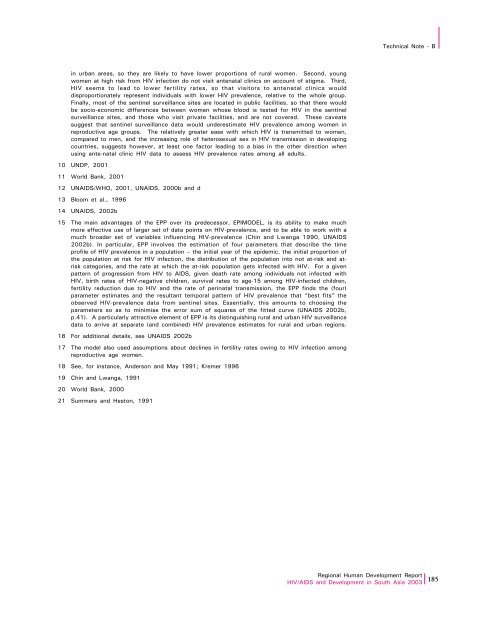Download Report - UNDP Asia-Pacific Regional Centre - United ...
Download Report - UNDP Asia-Pacific Regional Centre - United ...
Download Report - UNDP Asia-Pacific Regional Centre - United ...
Create successful ePaper yourself
Turn your PDF publications into a flip-book with our unique Google optimized e-Paper software.
Technical Note - Bin urban areas, so they are likely to have lower proportions of rural women. Second, youngwomen at high risk from HIV infection do not visit antenatal clinics on account of stigma. Third,HIV seems to lead to lower fertility rates, so that visitors to antenatal clinics woulddisproportionately represent individuals with lower HIV prevalence, relative to the whole group.inally, most of the sentinel surveillance sites are located in public facilities, so that there wouldbe socio-economic differences between women whose blood is tested for HIV in the sentinelsurveillance sites, and those who visit private facilities, and are not covered. These caveatssuggest that sentinel surveillance data would underestimate HIV prevalence among women inreproductive age groups. The relatively greater ease with which HIV is transmitted to women,compared to men, and the increasing role of heterosexual sex in HIV transmission in developingcountries, suggests however, at least one factor leading to a bias in the other direction whenusing ante-natal clinic HIV data to assess HIV prevalence rates among all adults.10 <strong>UNDP</strong>, 200111 World Bank, 200112 UNAIDS/WHO, 2001, UNAIDS, 2000b and d13 Bloom et al., 199614 UNAIDS, 2002b15 The main advantages of the EPP over its predecessor, EPIMODEL, is its ability to make muchmore effective use of larger set of data points on HIV-prevalence, and to be able to work with amuch broader set of variables influencing HIV-prevalence (Chin and Lwanga 1990, UNAIDS2002b). In particular, EPP involves the estimation of four parameters that describe the timeprofile of HIV prevalence in a population – the initial year of the epidemic, the initial proportion ofthe population at risk for HIV infection, the distribution of the population into not at-risk and atriskcategories, and the rate at which the at-risk population gets infected with HIV. or a givenpattern of progression from HIV to AIDS, given death rate among individuals not infected withHIV, birth rates of HIV-negative children, survival rates to age-15 among HIV-infected children,fertility reduction due to HIV and the rate of perinatal transmission, the EPP finds the (four)parameter estimates and the resultant temporal pattern of HIV prevalence that “best fits” theobserved HIV-prevalence data from sentinel sites. Essentially, this amounts to choosing theparameters so as to minimise the error sum of squares of the fitted curve (UNAIDS 2002b,p.41). A particularly attractive element of EPP is its distinguishing rural and urban HIV surveillancedata to arrive at separate (and combined) HIV prevalence estimates for rural and urban regions.16 or additional details, see UNAIDS 2002b17 The model also used assumptions about declines in fertility rates owing to HIV infection amongreproductive age women.18 See, for instance, Anderson and May 1991; Kremer 199619 Chin and Lwanga, 199120 World Bank, 200021 Summers and Heston, 1991<strong>Regional</strong> Human Development <strong>Report</strong>HIV/AIDS and Development in South <strong>Asia</strong> 2003 185
















